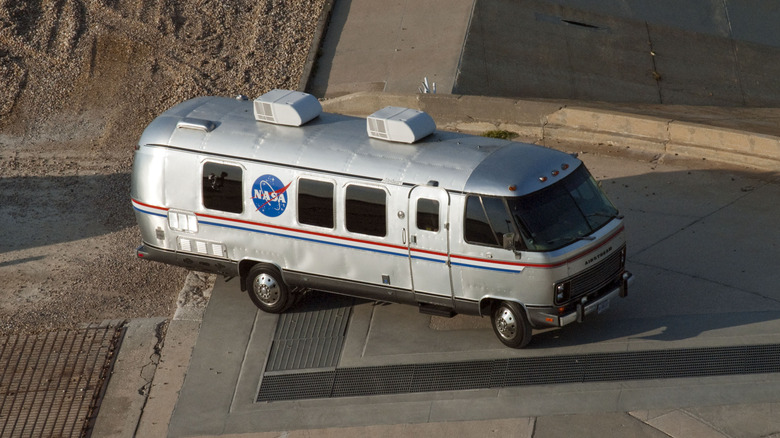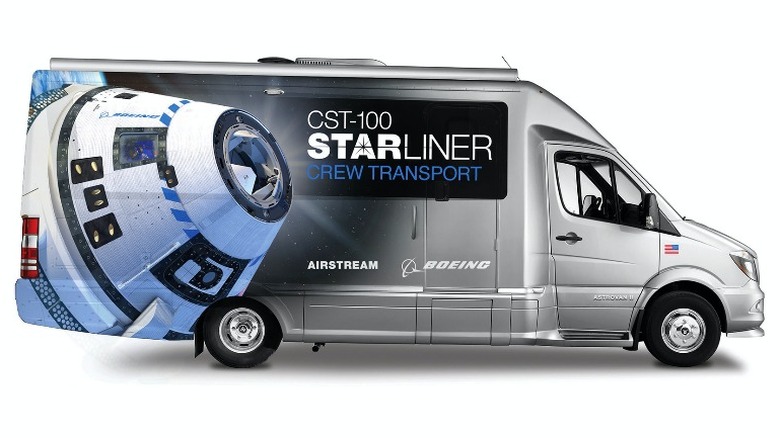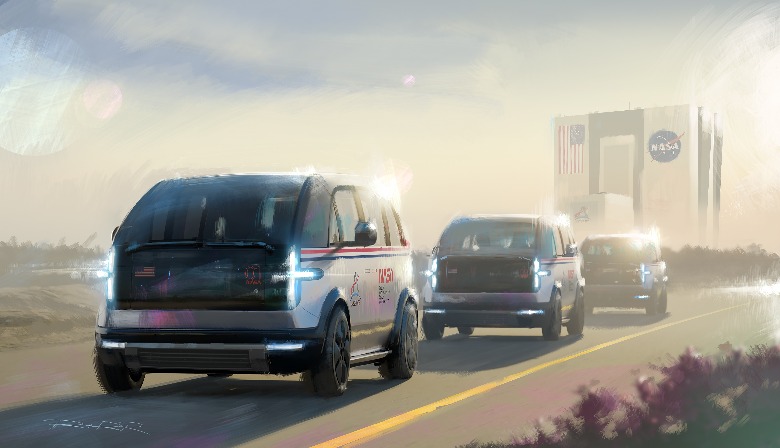These Are NASA's Replacements For The Original 1983 Astrovan
Between 1984 and 2011, every astronaut that went into space aboard the space shuttle took a 20-minute ride from the crew quarters to Launch Pad 39A aboard the now-iconic 1983 Airstream Astrovan. The Crew Transportation Vehicle only logged 26,500 miles during its 27 years at the Florida Kennedy Space Center. It only transported astronaut crews 9 miles to the launch pad for dress rehearsal, to the launch pad on launch day, and back after landing.
According to Airstream, the company was commissioned to build three modified Excella Motorhomes for NASA's Shuttle program. Instead of the usual living and dining areas typically found in an Astrovan, the modified Airstream had long bench seats along either side of the interior walls for the shuttle crew of eight. These benches had lift-out sections so the ventilator units used to move cool air through the astronaut's cumbersome suits would fit properly. Additional cargo could be loaded through a rear hatch with steps. Other standard features like the bathroom, a refrigerator, and the original dark-wood paneling and gold drapes remained.
The final mission for the classic Astrovan coincided with the last space shuttle mission (STS-135) in July 2011. Over its 27-year history, it had become part of a tradition — a piece of living history that connected astronauts through the ages. When NASA decided to look for a new transportation vehicle, many astronauts wanted to keep the Airstream — as much for nostalgia as for superstitions — not to mention the idea that keeping the original running might've been more practical than commissioning a whole new vehicle. The famous Astrovan can be seen inside the Kennedy Space Center Visitor's Complex in Cape Canaveral, Florida.
Hitching a ride into space
In 2019 Airstream unveiled the Astrovan II, intended for use in transporting astronauts for Boeing's CST-100 Starliner. The Astrovan II would've been only the latest in a line of projects worked on by Airstream for the American space program. From 1967 to 1968, the company built four Mobile Quarantine Facilities (MQFs) to quarantine the Apollo astronauts after returning from the moon. The fear was that astronauts might have come in contact with lunar pathogens while on our nearest space neighbor, and NASA didn't want them to spread.
NASA sent out a request for proposal (RFP) in 2021 to build a new Crew Transportation Vehicle for its upcoming Artemis missions. It would consider three options: Design and build a brand new, non-commercial vehicle; modify an existing commercial vehicle; refurbish the 1983 custom Airstream they already had. No matter what option was picked, it had to comply with the National Highway Transportation Safety Administration Standards, have exterior logos showing the CTV is the Artemis Crew Transportation Vehicle, and, more importantly... be "a zero-emission vehicle, including battery-electric, plug-in hybrid electric, or fuel cell electric."
On April 13, 2022, NASA announced the Artemis crew would be riding to Launch Pad 39B in vehicles designed by US electric vehicle manufacturer Canoo Technologies Inc. The new CTVs would be modified versions of the company's existing all-electric LV models, customized to seat four fully suited astronauts and four additional passengers.
The pod-shaped exteriors look futuristic while paying homage to that old '83 Astrovan. And maybe in time, Canoo's CTVs will be as traditional as that silver bullet.


